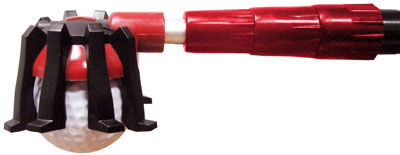Exposing the secrets of fake golf clubs
University scientists cut up the counterfeits

Scientists in Yorkshire have exposed the secrets of counterfeit golf clubs by using forensic technology to uncover the shoddy truth behind the near-perfect exteriors of a 3-wood imported from the Far East.
Experts from Sheffield Hallam University's Centre for Sport and Exercise Science and its materials engineering department put genuine and fake clubs through a series of tests to determine how they differed, both to the naked eye and internally.
They found that although some counterfeit clubs looked remarkably similar to the real thing, poor engineering means that they will break or deteriorate quickly and could make a marked difference to the quality of a golfer's game.
The clubs, one of which was obtained from trading standards following a recent court case in which fraudsters were jailed for passing off counterfeit clubs as genuine, were initially put through their paces by a local PGA professional. At first sight, he was unable to tell the difference between the two, the counterfeit seemingly having been put together extremely well. But, after a number of shots the fake club began to rattle, a tell tale sign that things were not as they should be.
When the clubs were taken apart and analysed by the University's forensic engineers the true extent of their differences were revealed.
Poor welding
Tests showed that despite the clubs being made of similar metals, the fake club had not been properly heat treated, making it weaker than the genuine club. Inside the head, the counterfeit had been poorly welded showing the lack of expertise.
Though both made of carbon fibre the fake and genuine shafts were also markedly different. While the genuine one was flexible, the counterfeit was much thicker and rigid and liable to snap.
A further tell-tale sign and one which the scientists reveal is a sure fire way to tell fake from genuine, was in the removable heel and toe weights screwed into the fake club's head. The toe weight, marked two grams, actually weighed 3.5 grams (55%heavier), while the heel weight marked 14 grams was actually 12 grams (14 % lighter than it should be).
Professor Alan Smith, from Materials Analysis and Research Services (MARS) at Sheffield Hallam, said: "The quality of the welding on the two clubs differed enormously. The real club was made using far more complex manufacturing techniques and precision engineering."
Less flexibility
"The fact that the counterfeit club had not been heat treated properly is very significant, because this is an expensive process designed to ensure the metal possesses the requisite hardness and toughness. The carbon fibre shafts were also strikingly different, the counterfeit having much less flexibility than the real club.
"A counterfeit club wouldn't last as long as a genuine club, so despite being cheaper they represent a false economy for amateur players."
Tim Vernon, from the Centre for Sport and Exercise Science, said: "The counterfeit club certainly looked genuine and at first, performed remarkably well in the hands of a professional player. It would be easy to see why amateurs could be fooled into buying a cheap fake off the internet but our forensic tests showed just how badly the counterfeit was actually put together."
Sheffield Hallam University has particular expertise in sports science, sports equipment technology and forensic engineering. For more details on courses, please visit their website.
A sure fire way to tell fake from genuine, is in the removable heel and toe weights screwed into the fake club's head.
�

